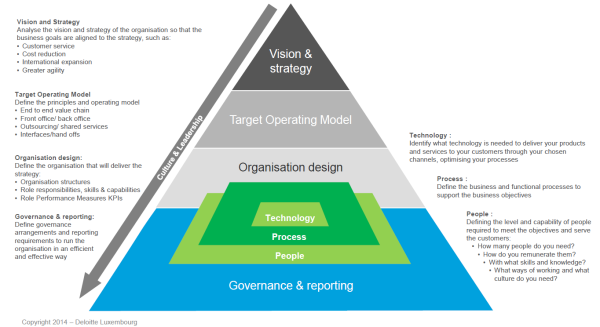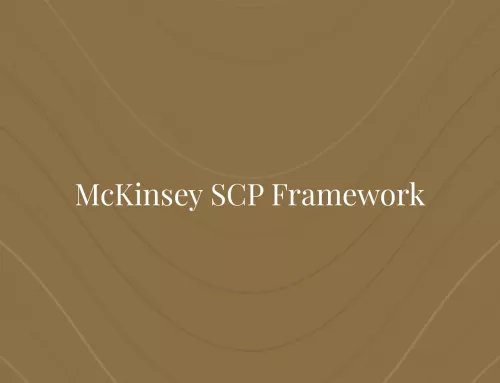Target operating model (TOM) is a blueprint of a firm’s business vision that aligns operating capacities & strategic objectives. It provides an overview of the core business capabilities, internal factors, & external drivers, strategic & operational levers, organizational & functional structure, technology, & information resources of a company. In today’s digital & cognitive world, it has become a strategic imperative to redefine what’s next & then realize the target state with a sound target operating model.
TOM Template
Deloitte has developed an approach that makes it easier for companies to design a specific TOM using various scenarios. Specifically, the key components of a TOM are well-aligned with the corporate strategy.

Target Operating Model From Deloitte Luxembourg
The procedure is divided into six categories:
- Optimization: Optimize the size, shape, structure and performance of the company
- Preparation for transformation: Identify gaps between the current and target state of the company, determine dependencies and impact of the change
- Consolidation: Bring together different business areas or divisions to ensure the alignment of key components (people, culture, technology, processes, etc.)
- Strategic planner: Clearly communicate the principles, objectives and the operational (implementation) details of the new business strategy
- Consensus building: Include a concrete set of structural views
- Cost reduction: Identify cost reduction potential and company-related inefficiencies
Case Study – TOM for a restaurant business
- Company: Benihana
- Vision: Bring Japanese cuisine to the world
- Strategy: Provide cultural ambiance & experience in addition to food
- Core Capabilities: Service Management, Food & Beverage Management, Inter-cultural Awareness, Brand Management etc.
- Processes: How does the restaurant deliver upon its promise & deliver authentic experiences?
- The welcoming the guest process
- The order taking process
- The food preparation process
- The billing process
- Each of these processes is important in realizing the vision & strategy
TOM Equation
There are three key objectives to developing a TOM & pursuing its cost effective realization. The objectives are to:
- Transform an organisation’s current operating state i.e. how it works now, which is described by its Current Operating Model (COM), to that described by its TOM
- Develop an organisation’s change capability so that it can react and adapt to change effectively and efficiently, without detriment to customers, quality of service, profitability, security, competitiveness, etc.
- Develop an organisation’s strategic planning capability so its TOM, divisional strategies and annual plans can be reviewed regularly to ensure they continue to be aligned and support the organisation’s strategy and direction
The purpose of these three objectives is for an organisation to get to a stage where the amount of change required to move its current operating state to its target operating state is minimized. Correspondingly, TOM can be formulated as:
Target Operating Model = Current Operating Model + change required
To aid the transformation journey, you may want to develop a number of Intermediate Operating Models (IOMs). These provide natural checkpoints & give further opportunity to review the TOM. The IOMs serve as operational states following significant transformation initiatives. For example, these may involve the implementation of a new system, acquisition of another company or major structural organisational changes.
Subsequently, to develop & realize the TOM, you need a strategic road map of change. Although a TOM provides the description of an organisation’s target operating state, you also need to determine the correct starting point. This is the organisation’s Current Operating Model (COM). Understanding the COM is a critical factor in maximizing an organisation’s chance of successfully realizing its TOM in a cost-effective way.
Current Operating Model
According to Deloitte, the Current Operating Model (COM):
is an operational framework that represents how an organisation is configured today. However, the Target Operating Model (TOM) shows a future state that the organisation should be moving towards in order to achieve its strategy.
If you are going to change the future state vision, strategy & how you deliver your service, you will need a future state operating model of how the new restaurant concept will look like. Therefore, the transformation journey is about enabling that future state operating model.
Components of a Target Operating Model
A Target Operating Model contents depend on various factors. The following are a general list of components of a TOM. You should determine the components that best work best for you based on your specific project requirements.
- External Drivers: Understand the broader trends in the economy, geo-politics, & related matters. A simple PESTLE Analysis (Political, Economic, Social, Technological, Legal, Environmental Analysis) would do help capture this information
- Internal Factors: Understanding the current state of the organization is a vital ingredient for defining a useful TOM. So, you can use a SWOT Analysis (Strengths, Weaknesses, Opportunities, Threats Analysis) to documenting the current state
- Competitive Dynamics: Assess the state of current competitors as well as emerging competitors, including upstart startups. You may consider using a Factor-based Analysis.
Culture & Core Values: What is the culture, folklore, & values of the firm? Besides, what is the target state culture you are striving for? - Vision & Mission: Future state envisioning will help in documenting the future state vision & mission of the company. It can be an incremental shift or a complete re-imagination of the future
Strategy & Plan: Define how your firm will get to the POA (Point of Arrival)
- Capability Analysis: Elaborate on what new capabilities are necessary, what current capabilities need to evolve, & which capabilities may require phasing out
- Strategic Levers: What strategic levers will help you achieve success in the future state?
- Tactical or Operational Levers: How will the future state operations & processes shift or evolve or leapfrog to make the future state operating model a reality?
- Transformation Road map: A transformation road map is an incremental & sequential evolution to the target state. Basically, the initiatives, programs & projects that define the types of actions, programs & plans necessary to get to the target state
- Governance Structure: How will you govern future state operations? Of course, while you will never know what the future holds exactly, it is an attempt to provide a framework for rule-setting & enforcement
- Key Performance Indicators: What does success mean & how do you measure?
How is a TOM different from a Business Model?
The business model delves into an organisation’s customers & product offerings (or value propositions) & how to effectively commercialize the business. It focuses on bringing about profits through revenue streams & product offerings. Concurrently, it looks at some of the activities & resources required to deliver the product offerings & service customers. The Business Model Canvas by Alexander Osterwalder & Yves Pigneur is a great tool that helps organisations evaluate their business model & pivot, if needed, when the enterprise ecosystem conditions change. At a high level, a business model describes the WHATs. In other words, it describes what an enterprise must do & change. In short, the business model defines the design.
The Operating Model, on the other hand, deals with the HOW, WHERE & WHEN. It is part of the execution life cycle of a business. Success comes from both, the design of good strategies & then the execution of those strategies. So, a business model without an operating model is lost & unlikely to succeed in delivering the value that it promises to a business enterprise & its customers.
How is a TOM different from a Strategy?
Business strategy & priorities change frequently based on external factors. But, a TOM provides the foundation & flexibility required to execute the firm’s initiatives. A strategy helps achieve the target operating model. In turn, the TOM influences a firm’s strategies.
Benefits of a TOM
- Provides a big picture of what the future steady state business may look like across business & technology domains
- Focuses on both hard & soft skills – structures, systems, staffing, style, & shared values
- Showcases how an organization or a business unit can deliver value & the value drivers thereof
- The fundamental constructs of a TOM will help provide the building blocks to define business architecture & systems architecture
Target operating model (TOM) is a blueprint of a firm’s business vision that aligns operating capacities & strategic objectives & provides an overview of the core business capabilities, internal factors, & external drivers, strategic & operational levers, organizational & functional structure, technology, & information resources of a company.




